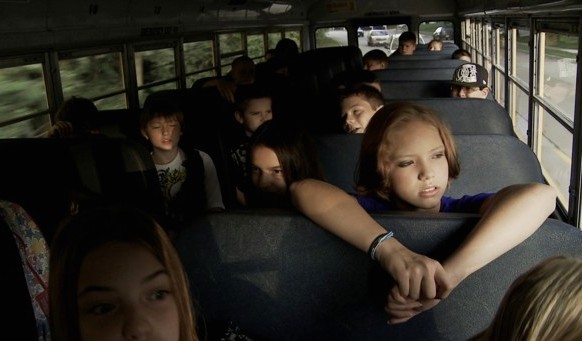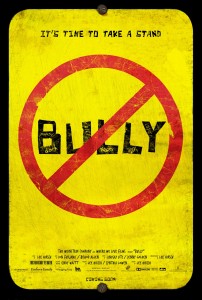
This is a look at the school violence problems in Middle America, although documentarian Lee Hirsch suggests it is a nationwide problem. Bully is the one film that might be helpful in alleviating the endemic by screening it at public schools (it would help pinpoint some problems, breakdown the unfair nature of intolerance). It was slapped with a restricted R rating by the MPAA that will prohibit school viewings. The hypocrisy is that the film is merely a look at what’s going with our own kids caught on camera, speaking the f-word in the way that is now customary on an everyday basis in school. How is incidental foul language used amongst kids today really going to offend? Here’s a social relations doc that’s enlightening for our contemporary classrooms and school board administrations. Yet the MPAA wants to be censored to prevent it from doing any good!
At first I was uncertain if Hirsch’s experiment was going to work, by cross-cutting between different case studies (Iowa, Oklahoma, Mississippi, and Georgia among the sites where families were selected). The unpopular kids, bullied on an everyday basis, get the cameras following them everywhere. But it doesn’t stop the bullies from punching Alex on the bus.
Even if you find such caught on film incidentals to be predictable/inevitable, what shocks is how out of touch general school administrators are about the definition of bullying. In all the media hoopla surrounding the film right now, it’s been one story after another about how “Bully” is necessary for students. Hirsch’s film is really necessary for principals, deans, disciplinarians who time and time again in this film are oblivious to the perpetrators, the fragilities of the victims, and the symptoms of hate and prejudice.
 Multiple kids receive “death threats” on a daily basis, but repeatedly it’s the deans, VP’s and principals who don’t find it a problem as long as there aren’t any bruises. When there are actual bruises, the aloof method of “can’t do much about that” seems to be the only solution for these ignoramuses who call themselves public servants. And there’s nothing more disheartening than seeing teachers punish the victim over the actual class troublemaker.
Multiple kids receive “death threats” on a daily basis, but repeatedly it’s the deans, VP’s and principals who don’t find it a problem as long as there aren’t any bruises. When there are actual bruises, the aloof method of “can’t do much about that” seems to be the only solution for these ignoramuses who call themselves public servants. And there’s nothing more disheartening than seeing teachers punish the victim over the actual class troublemaker.
If there’s a veritable dramatic episode in the film, it’s when 14-year old Ja’meya is arrested with 22 felony counts for waving a gun at classmates on a bus who have been tormenting her for years (the police are unsympathetic). Other kids have reached the end of their rope, and their destruction was more implosive: the film begins and ends with interviews of families that lost their 17 and 12 year olds to suicide as a means to escape bullying. That inspired the beginning of a grassroots movement of parents against bullying that rallies at the film’s culmination.
If bullies saw this film, it’s hard to say, but they might see that their antagonistic behavior is cowardly and that their antithesis to real growing up. Then we could tease them as the boneheads.
94 Minutes. Rated PG-13.
DOCUMENTARY / FOOD FOR THOUGHT / FALL SCHOLASTICS
Film Cousins: “Show Me Love” (1998, Sweden); “The Class” (2008, France); “Precious: Based on the Novel ‘Push’ by Sapphire” (2009); “Waiting for Superman (2010).






hashbrowny says,
What are your thoughts on the rated R vs PG-13 controversy?
on April 10, 2012
Sean Chavel says,
“Bully” received an R rating, all because the F#!% word was used a few times. Studio head Harvey Weinstein decided to release the film Unrated. This sounds like a solution, but Unrated films aren’t run in some movie theater chains. The box office receipts will be inevitably damaged. If a DVD release bleeps out the bad words (which we’ve all heard), then this documentary might get screened in schools as a learning aid.
on April 26, 2012